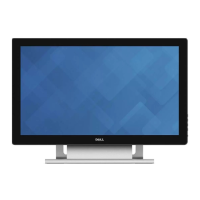
Do you have a question about the Dell S2240Tb and is the answer not in the manual?
| Screen Size | 21.5 inches |
|---|---|
| Panel Type | IPS |
| Refresh Rate | 60 Hz |
| Brightness | 250 cd/m² |
| Contrast Ratio | 1000:1 |
| Aspect Ratio | 16:9 |
| Touch Points | 10-point multi-touch |
| Touchscreen | Yes |
| Resolution | 1920 x 1080 |
| Ports | HDMI, USB |
| Viewing Angle | 178° (H) / 178° (V) |
| Touch Technology | Projected Capacitive |
| VESA Mount | Yes |
Lists the items included with the monitor.
Details the key features and specifications of the Dell S2240T monitor.
Details the components visible from the front of the monitor.
Explains the buttons located on the side of the monitor.
Identifies ports and features on the back of the monitor.
Shows the side profile and stand of the monitor.
Details the connectors and ports located on the bottom of the monitor.
Lists detailed technical specifications of the monitor's panel.
Details the supported resolution modes and scan ranges.
Lists the various video modes supported by the monitor.
Details the electrical characteristics of the monitor.
Provides physical dimensions, weight, and connector types.
Outlines operating conditions like temperature, humidity, and altitude.
Explains the monitor's power saving features and consumption.
Details the specifications related to the monitor's touch functionality.
Lists pin assignments for the VGA connector.
Lists pin assignments for the DVI connector.
Lists pin assignments for the HDMI connector.
Explains how the monitor works with Plug and Play systems.
Provides information about the monitor's USB ports and data rates.
Explains the policy regarding monitor quality and pixel defects.
Provides instructions for cleaning and maintaining the monitor.
Instructions on how to attach the monitor stand.
General instructions for connecting the monitor to a computer.
Illustrates how to connect the HDMI cable.
Illustrates how to connect the DVI cable.
Illustrates how to connect the VGA cable.
Instructions for connecting the USB cable for touch functionality.
Guidance on tidying up the monitor cables.
Steps to detach the monitor stand.
Instructions for mounting the monitor on a wall.
How to turn the monitor on using the power button.
Explains the function of the monitor's side control buttons.
Details the functions of the up/down/OK/back buttons.
How to launch, navigate, and use the monitor's OSD menu.
How to launch and navigate the monitor's OSD menu.
Displays the main menu options for VGA input.
Displays the main menu options for DVI input.
Displays the main menu options for HDMI input.
How to adjust the monitor's brightness and contrast settings.
Explains the automatic adjustment feature for display settings.
How to select the active video input source for the monitor.
Options for adjusting color settings and input format.
How to set the video input mode to RGB or YPbPr.
Describes various preset color modes for different applications.
How to adjust the color tone of the video image.
How to adjust the color saturation of the video image.
Splits the screen to view images side-by-side for comparison.
Improves image quality by reducing fading and edge roughness.
Resets monitor color settings to factory defaults.
Adjusts aspect ratio, position, and sharpness of the display.
Adjusts the image ratio to Wide 16:9, 4:3, or 5:4.
Adjusts the image position horizontally on the screen.
Adjusts the image position vertically on the screen.
Adjusts the sharpness or softness of the image.
Adjusts the pixel clock for optimal image quality.
Fine-tunes image quality by adjusting the phase.
Enhances contrast for sharper, more detailed images.
Restores all display settings to their factory defaults.
Accesses settings like language, menu timer, and DDC/CI.
Sets the OSD display language for the monitor.
Adjusts the transparency level of the OSD menu.
Sets how long the OSD menu remains active.
Controls user access to monitor adjustments.
Turns dynamic dimming on or off for power saving.
Enables/disables monitor parameter adjustment via computer software.
Helps reduce image retention by running a program.
Resets all OSD settings to factory preset values.
Sets features as shortcut keys for quick access.
Explains warning messages related to Energy Smart, Dynamic Contrast, and resolution.
Steps to set the display resolution to 1920 x 1080.
Instructions on how to tilt the monitor for comfortable viewing.
How to run a self-test to check monitor functionality.
Tool to determine if screen issues are monitor or computer related.
Instructions to enter and exit the in-store demo mode.
Troubleshooting steps for a monitor with no picture and power off.
Troubleshooting steps for a monitor with no picture but power on.
Solutions for fuzzy, blurry, or ghosting picture issues.
Solutions for wavy or fine movement in video display.
Explains issues related to dead pixels on the screen.
Explains issues related to pixels stuck on bright.
Troubleshooting steps for a picture that is too dim or too bright.
Solutions for screen images that are not centered correctly.
Troubleshooting steps for lines appearing on the screen.
Solutions for scrambled or torn screen images.
Addresses critical safety issues like visible smoke or sparks.
Troubleshooting steps for intermittent monitor malfunctions.
Solutions for issues with missing colors in the picture.
Troubleshooting steps for incorrect picture colors.
Solutions for faint shadows from static images.
Solutions for touch misalignment or lack of touch function.
Solutions for when the screen does not respond in power saving mode.
Steps to calibrate the touch screen on Windows 7/8.
Addresses specific issues like small screen image or OSD lock.
General safety warnings for using the monitor.
Regulatory information and compliance details for the monitor.
Information on how to contact Dell for support and service.
Instructions for setting up the monitor, specifically display resolution.
Steps to set the display resolution to 1920 x 1080.